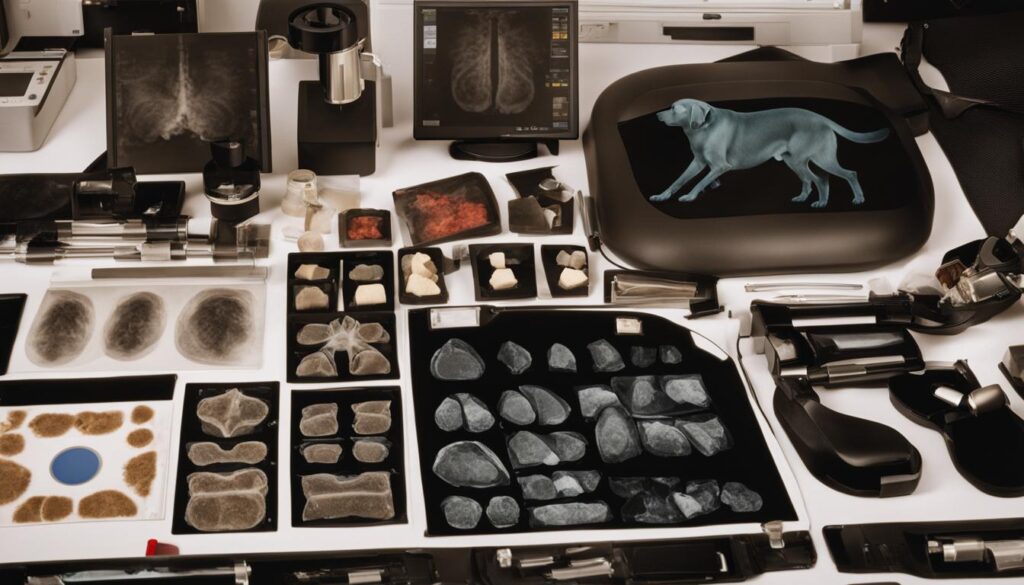Pulmonary fibrosis in dogs is a chronic and progressive lung disease characterized by scarring, stiffness, and thickening of the lung tissue. It is a serious condition that can significantly impact a dog’s quality of life. As a copywriting journalist, I aim to provide you with valuable information and insights into this condition, its symptoms, diagnostic approaches, treatment options, and prognosis.
Key Takeaways:
- Pulmonary fibrosis in dogs is a chronic and progressive lung disease.
- Symptoms include exercise intolerance, respiratory distress, decreased appetite, and cough.
- Diagnostic approaches may involve thoracic imaging, blood work, bronchoscopy, and ultrasound.
- Treatment focuses on supportive care and symptom management.
- The prognosis varies depending on the degree of lung damage and response to treatment.
Causes and Risk Factors of Pulmonary Fibrosis in Dogs
Pulmonary fibrosis in dogs can have various causes and risk factors. While some cases may be secondary to underlying conditions such as pneumonia, chronic bronchitis, or congestive heart failure, others are categorized as idiopathic pulmonary fibrosis, where the cause remains unknown. It is believed that there is a genetic link to this condition, particularly in certain breeds such as the West Highland White Terrier. These dogs have a higher risk of developing pulmonary fibrosis, and the condition is more prevalent among terrier breeds.
In secondary cases, the scarring and thickening of lung tissue occur as a result of chronic injury and healing. The damage may be caused by infections, chronic inflammation, or exposure to environmental pollutants. However, in idiopathic cases, the exact trigger is yet to be identified. Ongoing research aims to uncover potential genetic mutations associated with pulmonary fibrosis in dogs, shedding light on the underlying causes and contributing to future advancements in diagnosis and treatment.
It is important for dog owners to be aware of the potential risk factors and symptoms of pulmonary fibrosis, especially if they have a breed that is predisposed to this condition. Early detection and management can help improve the dog’s quality of life and potentially slow down the progression of the disease. Regular veterinary check-ups and prompt evaluation of any concerning respiratory symptoms are crucial in the care of dogs at risk for or diagnosed with pulmonary fibrosis.
Genetic Link in West Highland White Terriers
The West Highland White Terrier, commonly known as the Westie, is one of the breeds that is more susceptible to developing pulmonary fibrosis. Genetic factors play a significant role in this breed’s predisposition to the disease. Dogs with a family history of pulmonary fibrosis are at a higher risk, emphasizing the importance of responsible breeding practices.
While the exact mode of inheritance is not fully understood, it is believed to be a complex trait involving multiple genetic factors. Researchers are studying the DNA of affected dogs to identify potential gene mutations associated with the development of pulmonary fibrosis. This research not only aids in understanding the disease better but also provides valuable information for breeders to make informed decisions and reduce the incidence of pulmonary fibrosis in West Highland White Terriers.
Symptoms of Pulmonary Fibrosis in Dogs
When it comes to identifying pulmonary fibrosis in dogs, it’s important to recognize the telltale symptoms. Dogs with this condition often exhibit exercise intolerance, meaning they struggle with physical activity and tire easily. You may notice that your furry companion is not as eager to go for walks or play as they used to be. This decreased stamina is a result of the scarring, stiffness, and thickening of the lung tissue associated with pulmonary fibrosis.
In addition to exercise intolerance, dogs with pulmonary fibrosis may also experience respiratory distress. This can manifest as rapid or labored breathing, and you may notice your dog struggling to take in enough air. They may also exhibit a persistent cough, which is often nonproductive. These respiratory symptoms are indicative of the lung damage caused by the disease and can significantly impact your dog’s quality of life.
Another common symptom of pulmonary fibrosis in dogs is decreased appetite. As the disease progresses, dogs may lose interest in food or eat less than usual. This can lead to weight loss and further impact their overall well-being. If you notice any of these symptoms in your dog, it’s essential to seek veterinary care for a proper diagnosis and appropriate management of the condition.
Diagnosing Pulmonary Fibrosis in Dogs
Diagnosing pulmonary fibrosis in dogs involves a combination of clinical signs, physical examination, and diagnostic testing. As a veterinarian, I rely on various diagnostic tools to confirm the presence of this progressive lung disease. One of the most common tests used is a CT scan, which provides detailed images of the lungs and helps identify scarring and thickening of the lung tissue. X-rays are also useful in visualizing lung abnormalities and assessing the extent of the disease.
Blood work is another crucial component of the diagnostic process. It helps rule out other potential causes for the dog’s symptoms and provides valuable insights into the overall health of the patient. Bronchoscopy, a procedure that allows direct visualization of the airways, may be performed to collect samples for further analysis. Ultrasound is often utilized to assess the heart and identify any associated complications.
By combining the information gathered from these diagnostic tests, along with the dog’s clinical signs and history, I am able to make a definitive diagnosis of pulmonary fibrosis. It is important to conduct a thorough evaluation to differentiate it from other respiratory conditions and ensure an accurate diagnosis.

Further Investigation: Lung Biopsy
In some cases, when other diagnostic methods are inconclusive, a lung biopsy may be recommended. This is a more invasive procedure where a small sample of lung tissue is obtained for microscopic examination. A lung biopsy allows for a definitive diagnosis of pulmonary fibrosis, confirming the presence of fibrotic changes in the lung tissue.
However, it is important to note that a lung biopsy is generally reserved for research purposes or when the diagnosis is in question. Due to its invasive nature, the risks and potential complications must be carefully considered, particularly for dogs with compromised respiratory function.
In conclusion, diagnosing pulmonary fibrosis in dogs involves a combination of clinical signs, physical examination, and diagnostic testing. CT scans, x-rays, blood work, bronchoscopy, and ultrasound are valuable tools that help veterinarians confirm the presence of this progressive lung disease. A thorough evaluation is essential to differentiate pulmonary fibrosis from other respiratory conditions and ensure an accurate diagnosis. In some cases, a lung biopsy may be necessary for a definitive diagnosis, but it is typically reserved for research purposes or when other diagnostic methods are inconclusive.
Treatment Options for Pulmonary Fibrosis in Dogs
Pulmonary fibrosis in dogs is a challenging condition to manage, as there is currently no cure. However, veterinary management aims to provide supportive care and alleviate symptoms to improve the dog’s quality of life. Medications play a crucial role in symptom relief and may be prescribed by a veterinarian.
One of the main treatment options for dogs with pulmonary fibrosis is the use of steroids. Steroids can help reduce inflammation in the lungs and ease breathing difficulties. Bronchodilators, such as theophylline, are also commonly prescribed to help relax the airways and improve pulmonary function. These medications can assist in managing symptoms like coughing and respiratory distress.
Additionally, sedatives may be prescribed to help calm dogs with anxiety or restlessness related to their condition. Cough suppressants can also be used to provide relief from persistent coughing, which is a common symptom of pulmonary fibrosis. It is important to work closely with a veterinarian to determine the most suitable medication regimen for each individual dog, as the dosage and frequency may vary based on the dog’s specific needs and response to treatment.
Supportive Care and Oxygen Supplementation
In addition to medications, supportive care plays a vital role in managing dogs with pulmonary fibrosis. Oxygen supplementation may be necessary for dogs experiencing severe respiratory distress. Providing supplemental oxygen can help improve oxygen levels in the blood and alleviate breathing difficulties.
Other supportive care measures include maintaining a calm and stress-free environment for the dog, as stress can exacerbate respiratory symptoms. A nutritious diet tailored to the dog’s specific needs may also be recommended to support overall health and immune function. Regular check-ups with the veterinarian are essential to monitor the dog’s condition and make any necessary adjustments to the treatment plan.
While there is no cure for pulmonary fibrosis in dogs, the combination of veterinary management, medications, and supportive care can help improve the dog’s quality of life and provide relief from symptoms. It is important for dog owners to work closely with their veterinarian to develop a comprehensive treatment plan tailored to their dog’s specific needs and monitor their condition closely over time.
The Prognosis of Pulmonary Fibrosis in Dogs
When it comes to pulmonary fibrosis in dogs, the prognosis can vary depending on the degree of lung damage at the time of diagnosis. On average, the life expectancy for dogs diagnosed with pulmonary fibrosis is 12-18 months. However, it’s important to keep in mind that this estimate can be influenced by several factors. The severity of symptoms, the overall health of the dog, and the response to treatment all play a role in determining the prognosis.
Dogs with more advanced stages of pulmonary fibrosis may experience more severe symptoms and a shorter life expectancy. In contrast, dogs with milder forms of the disease and less lung damage may have a longer life expectancy and a better quality of life. Regular monitoring of the dog’s condition and close collaboration with a veterinarian are essential in managing their care and ensuring the best possible outcome.
While there is no cure for pulmonary fibrosis in dogs, supportive care can help alleviate symptoms and improve the dog’s quality of life. Medications such as steroids, bronchodilators, and antitussives may be prescribed to reduce inflammation, improve breathing, and provide relief from coughing. Additionally, oxygen supplementation may be necessary for dogs with severe respiratory distress.
Monitoring and Tailored Care
Regular check-ups and diagnostic testing are crucial for monitoring the progression of pulmonary fibrosis in dogs. This allows veterinarians to adjust the treatment plan as needed and provide tailored care based on the individual dog’s needs. By closely monitoring the dog’s condition, veterinarians can ensure that any changes in symptoms or lung function are promptly addressed, optimizing the dog’s comfort and well-being.
Overall, while the prognosis for dogs with pulmonary fibrosis can be challenging, early diagnosis and comprehensive management can greatly improve their quality of life. With ongoing research and advancements in treatment options, there is hope for further enhancing the prognosis and outcomes for dogs affected by this challenging lung disease.
Pulmonary Fibrosis Research in Dogs
Research on pulmonary fibrosis in dogs is crucial for understanding the underlying causes and identifying potential genetic mutations associated with the condition. By studying affected dogs and comparing them to unaffected dogs, researchers aim to identify specific gene mutations that may predispose dogs to develop pulmonary fibrosis. This research not only improves the diagnosis of the disease but also helps in developing targeted treatments and making informed breeding decisions to reduce the prevalence of pulmonary fibrosis in certain dog breeds.
One area of focus in pulmonary fibrosis research is identifying the genetic mutations that contribute to the development of the disease. By analyzing blood DNA samples from affected dogs, researchers can pinpoint specific gene mutations that may be linked to the condition. This information can help veterinarians in diagnosing pulmonary fibrosis and also guide breeding decisions by identifying dogs at risk of passing on the genetic mutations.
Participating in pulmonary fibrosis research is an opportunity for dog owners to contribute to the advancement of knowledge in the field. By providing blood samples from their affected dogs, owners can help researchers gather valuable data that may lead to improved treatments and better outcomes for dogs with pulmonary fibrosis. While there is currently no financial compensation for participating in research outside of the University of Minnesota Small Animal Hospital, the collective effort of dog owners can significantly contribute to the understanding and management of this challenging disease.
Genetic Studies on Pulmonary Fibrosis in Dogs
In recent years, genetic studies on pulmonary fibrosis in dogs have made significant progress in identifying gene mutations associated with the disease. These mutations may be breed-specific, suggesting a hereditary component to the condition. By uncovering these genetic links, researchers can develop genetic tests that can help identify dogs at risk of developing pulmonary fibrosis, allowing for early intervention and more targeted management of the disease.
Overall, ongoing research on pulmonary fibrosis in dogs strives to enhance our understanding of the disease and improve the lives of affected animals. Through collaborative efforts between veterinarians, researchers, and dog owners, advancements can be made in early diagnosis, treatment options, and prevention strategies, ultimately aiming to reduce the burden of pulmonary fibrosis in dogs and improve their overall well-being.
Participating in Pulmonary Fibrosis Research
If you are a dog owner and want to make a meaningful contribution to the advancement of pulmonary fibrosis research, you have the opportunity to participate in genetic studies. By providing a small blood sample from your affected dog, you can help researchers isolate DNA and compare it to samples from unaffected dogs. This crucial step allows scientists to identify potential gene mutations associated with pulmonary fibrosis, leading to a better understanding of the condition and the development of new treatments.
Participating in pulmonary fibrosis research not only helps further scientific knowledge but also has the potential to improve outcomes for dogs with this condition. While there is currently no financial compensation for participating in research outside of the University of Minnesota Small Animal Hospital, your contribution can make a difference in the lives of dogs affected by pulmonary fibrosis.

Joining a genetic study is a simple yet impactful way to support ongoing research efforts. By becoming a participant, you become part of a collective effort to unravel the mysteries of pulmonary fibrosis and drive progress in understanding and treating this disease. Your dedication can pave the way for future breakthroughs and help veterinarians provide better care for dogs diagnosed with pulmonary fibrosis.
Diagnostic Approaches for Pulmonary Fibrosis in Dogs
When it comes to diagnosing pulmonary fibrosis in dogs, veterinarians utilize various diagnostic approaches to accurately identify the condition. These approaches include thoracic imaging, such as X-rays or CT scans, which can reveal characteristic changes in the lungs such as scarring and thickening. This imaging helps provide valuable insights into the extent and severity of the disease. Additionally, echocardiography may be used to assess pulmonary hypertension, a common complication of pulmonary fibrosis.
Pulmonary function testing is another diagnostic approach that can be employed to evaluate pulmonary impairment and oxygenation levels. This type of testing helps determine the functionality and efficiency of the lungs, aiding in the diagnosis and management of pulmonary fibrosis in dogs.
In some cases, bronchoscopy and bronchoalveolar lavage (BAL) may be performed. These procedures help rule out other diseases and assess the inflammatory response in the airways, providing further information to assist in the diagnosis and treatment of pulmonary fibrosis.
Image:
In rare cases where other diagnostic methods are inconclusive, a lung biopsy may be recommended for definitive diagnosis. However, lung biopsies are typically reserved for research purposes due to their invasive nature and associated risks.
By employing a combination of these diagnostic approaches, veterinarians can accurately diagnose pulmonary fibrosis in dogs, enabling them to develop appropriate treatment plans and provide the best possible care for affected animals.
Supportive Care for Dogs with Pulmonary Fibrosis
When it comes to managing pulmonary fibrosis in dogs, supportive care is essential. This involves providing treatments and interventions that help alleviate symptoms and improve the dog’s quality of life. One important aspect of supportive care is oxygen supplementation, which can help improve hypoxemia and pulmonary vasodilation, making it easier for dogs to breathe.
In addition to oxygen supplementation, there are medications that can be used to manage symptoms associated with pulmonary fibrosis. Glucocorticoid therapy, such as prednisone, may be prescribed to reduce inflammation in the lungs. While it cannot reverse fibrosis, it can help minimize the inflammatory response and provide some relief. Bronchodilators, like theophylline, can also be used to help with pulmonary hypertension, which is a common complication of the disease.
Another symptom that dogs with pulmonary fibrosis often experience is coughing. To provide symptomatic relief, antitussives may be prescribed. These medications can help suppress the urge to cough and minimize discomfort for the dog. It’s important to work closely with a veterinarian to determine the best course of treatment for each individual dog and monitor their response to therapy. Supportive care plans may vary depending on the dog’s specific needs and the severity of their condition.
Conclusion
In conclusion, pulmonary fibrosis is a challenging and complex lung disease that affects dogs. While there is currently no cure for this condition, veterinary management focuses on reducing symptoms and providing supportive care to improve the dog’s quality of life.
Medications, such as steroids, bronchodilators, sedatives, and cough suppressants, may be prescribed to alleviate symptoms and help manage the disease. Oxygen supplementation is often necessary for dogs with severe respiratory distress. It is important for dog owners to work closely with their veterinarian to create a tailored treatment plan that addresses their dog’s specific needs.
Prognosis for dogs with pulmonary fibrosis can vary depending on factors such as the degree of lung damage and response to treatment. Ongoing research is actively investigating the genetic mutations associated with pulmonary fibrosis in dogs, which may lead to advancements in diagnosis and treatment options in the future.
By participating in research studies, dog owners can contribute to the understanding of pulmonary fibrosis and potentially improve outcomes for dogs affected by this condition. Together, we can strive to provide the best possible care and support for dogs with pulmonary fibrosis.
FAQ
What is pulmonary fibrosis in dogs?
Pulmonary fibrosis in dogs is a chronic and progressive lung disease characterized by scarring, stiffness, and thickening of the lung tissue.
What are the symptoms of pulmonary fibrosis in dogs?
Dogs with pulmonary fibrosis may exhibit symptoms such as exercise intolerance, respiratory distress, decreased appetite, and cough.
How is pulmonary fibrosis in dogs diagnosed?
Diagnosis of pulmonary fibrosis in dogs is often confirmed through diagnostic testing including CT scan, x-rays, blood work, bronchoscopy, and ultrasound.
Is there a cure for pulmonary fibrosis in dogs?
Unfortunately, there is currently no cure for pulmonary fibrosis in dogs. Veterinary management focuses on reducing symptoms and providing supportive care.
What is the average life expectancy for dogs with pulmonary fibrosis?
The average life expectancy for dogs with pulmonary fibrosis is 12-18 months.
What are the causes of pulmonary fibrosis in dogs?
The exact cause of pulmonary fibrosis in dogs is not always known, but it can be secondary to underlying conditions or have a genetic link, particularly in certain breeds.
Can dogs with pulmonary fibrosis be treated?
While there is no cure, veterinary management focuses on reducing symptoms. Medications such as steroids, bronchodilators, sedatives, and cough suppressants may offer some relief.
How can I participate in pulmonary fibrosis research for dogs?
Dog owners interested in participating in pulmonary fibrosis research can provide a blood sample from their affected dog to help advance our understanding of the condition.
How is pulmonary fibrosis in dogs diagnosed?
Diagnosis involves a combination of clinical signs, physical examination, and diagnostic testing. This may include thoracic imaging, pulmonary function testing, bronchoscopy, and more.
What supportive care options are available for dogs with pulmonary fibrosis?
Supportive care may involve oxygen supplementation, glucocorticoid therapy, bronchodilators, and antitussives to help alleviate symptoms.



